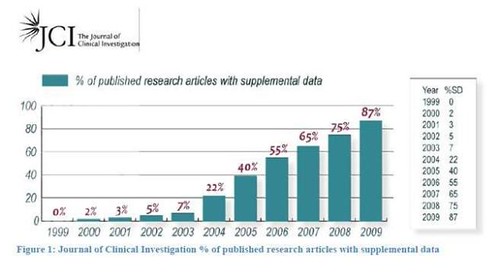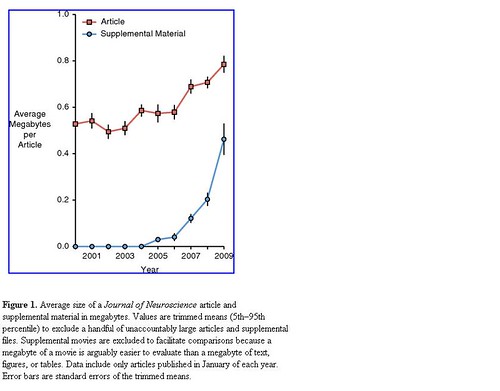At the Spring CNI Taskforce meeting last April, Karen Wetzel (Standards Program Manager at NISO) announced a new piece of work related to “supplemental materials” in journal articles. In the scientific literature, it is not uncommon for articles to be accompanied by a secondary set of figures, data, documentation of experimental protocols that aren’t considered part of the core content. Karen reported that thought-leaders from a variety of sectors had expressed concerns about the expense that publishers incur in managing this material, as well as the additional work that it creates for editorial staff and authors. Libraries were included in a long list of potential stakeholders, as potential curators of this supplemental material.
A central concern is that scholarly citation and reuse of this kind of supporting material is limited by the absence of identifiers, bibliographic metadata etc. This is especially true for disciplines that lack official data centers that might provide DOI registration etc. to support discovery, preservation and even re-discovery services. As Sasha Schwarzman of the American Geophysical Union observes, this has important consequences for the longevity of the scholarly record:
while the main article is going to enjoy eternal life with many reincarnations along the way, supporting material is likely to rot and die, with very little possibility of resuscitation
[Alexander (Sasha) Schwarzman. Supporting Material. 2 November 2009]
There are some equally important operational and economic considerations. From an editorial perspective, there is concern that the “core” of an article may be buried in supplemental material, which is not always subject to rigorous peer review. From a publisher perspective, there is a reluctance to assume the costs of managing, marking up etc this content. From the researcher/author perspective, there is concern about how contributions are credited (e.g. first author on supplemental material v. fourth on the article) and confusion about standard formats for submission of supplemental materials.
In spite of all this, the trend is reportedly toward an increasing burden of supplemental materials in the journal literature. The Journal of Clinical Investigation (0021-9738) — which charges authors a supplemental fee for supplemental materials –- reports that the percentage of article submissions accompanied by secondary figures, data etc has been rising steadily in recent years:

[Report of the Roundtable on Best Practices for Supplemental Journal Article Materials, Co-Sponsored by NFAIS and NISO, January 22, 2010]
I do not know what the outcomes of the NISO/NFAIS effort in this area have been thus far. Several working groups were to have been convened this summer, so presumably the work is still in course. Meanwhile, I was interested to see that the top-ranked Journal of Neursocience (1529-2401) has formally announced that it will no longer accept supplemental materials with article submissions. Henceforth, non-essential figures, tables, code libraries etc will be referenced in a footnote linked to an external Web site. Data sets and multimedia files will be accepted as part of the article content, but everything else will have to be hosted externally.
The Journal of Neuroscience points to the rapid increase in the size of supplemental materials submitted with manuscripts as a factor in its decision.
[“Announcement Regarding Supplemental Material” The Journal of Neuroscience, August 11, 2010, 30(32):10599-10600]
Optimistically, one might say the problem will resolve itself: aspiring authors will be forced — by editorial boards — to do a better job of writing articles that include all the necessary data and figures without recourse to voluminous supplements. Elegance and concision will be restored in the scientific literature, etc. But I would think this might still have knock-on effects for research institutions and perhaps libraries, as responsibility for managing those external websites will likely devolve to place where the work was performed.
As publishers like the J of Neuroscience renegotiate their role in scholarly communication and retrench their investment in the downstream products of research, universities will need to allocate more resource to managing the upstream processes and by-products of scientific/research practice.
This struck me as an instructive example of the “attention switch” that Lorcan Dempsey and Jim Michalko have talked about recently (here and there), viz., a change in the traditional library effort to bring the outside in by acquiring published content, to moving the inside out — taking greater responsibility for the stewardship of locally created research, teaching and learning materials.
Constance Malpas is Executive Director, Research and Programming. She joined OCLC in 2006, first working with the Research Library Partnership and later as a Research Scientist and Strategic Intelligence Manager. Constance is the author/co-author of multiple OCLC Research publications on library collections and services, collaboration, and the evolving higher education landscape.

This is exactly the sort of thing I had in mind — and a very sensible way to demonstrate that the IR solves a problem faced by researchers (rather than a problem faced by libraries, which I think is often how the IR is perceived — a kind of library folly). There is still the question of whether these materials are best managed locally (in an IR) or collectively (in a disciplinary repository, for example). Thanks for providing a concrete example of how Sydney is addressing this.
We at the University of Sydney have had a few cases of this sort of activity in the past year. As a result we have taken it upon ourselves to assist the author(s) by providing them with space in our IR to archive the supplemental materials thus providing a permanent link to the material that they may quote in their work. As Chris noted we saw this as an “opportunity” to promote our service.
Indeed, I was surprised when I went looking for examples of supporting materials in JCI, JoN and major journals, to find that they are merely presented as concatenated references in a single PDF file. I’ve wondered how (or if) this is being addressed in the joint project by NLM and the Optical Society of America to develop new models for interactive scientific publications. The project is mentioned in the NFAIS/NISO report I referenced above. My understanding (from a short briefing at a CNI meeting several years ago) was that they were endeavoring to integrate more of the underlying data and visualization tools directly into the article. I do not recall if they had assigned responsibility for preservation of this integrated data to the publisher, researcher/institution, or funder. As you say, this seems like an area where libraries might collectively wish to define a role.
Supplementary materials are an important source of the “data behind the graph”. Some of these data could go into a well-structured article directly, but page limits and the nature of the rhetorical argument often make that difficult. Some could be encoded within the text (eg as RDF representations of graphs and tables) if the paper weren’t locked into the PDF “digital representation of paper” format. In the absence of alternatives, JoN’s position seems unfortunate, particularly if it gives no guidance on the nature of the external web site to be referenced. The most likely candidate for most authors will be an author (or possibly research project or group) web site, and it is the transitory nature of these that seriously worries me. They are much more likely to simply vanish in some remote act of policy-led deletion than to ever get the chance to rot and die.
However, there may be a real opportunity for libraries here, if they are prepared to be hospitable and long-lived homes for externally referenceable supplementary materials. Libraries could easily do a much better job than publishers here; even Nature publishes most supplementary materials as PDFs; page after page of numerical tables are not a particularly hard act to beat!